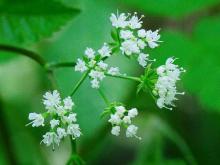Wildflowers, Grasses and Other Nonwoody Plants
Media

Species Types
Scientific Name
Allium stellatum
Description
Wild onion is edible and is also favored by native-plant gardeners, who enjoy its showy umbels of pink flowers and tolerance of dry, rocky sites. This Ozark species blooms in summer and fall.
Media

Species Types
Scientific Name
Cirsium vulgare
Description
Bull thistle is a weedy introduction from Europe, found statewide. To tell it from our other thistles, note its stems with spiny-margined wings, and its leaves with the upper surface strongly roughened with stiff, spiny bristles.
Media

Species Types
Scientific Name
Cirsium altissimum
Description
Tall thistle is a native thistle that can grow to be 10 feet tall! To identify it, notice its leaves, which are unlobed (though they may be wavy or have only shallow, broad lobes), are felty-hairy beneath, and have prickles only along the edges.
Media

Species Types
Scientific Name
Cardamine bulbosa
Description
Like many of its relatives in the mustard family, spring cress has a bitter or pungent flavor, similar to horseradish. It is sometimes used as a condiment and in salads. Or you could just enjoy the pretty white flowers!
Media

Species Types
Scientific Name
Osmorhiza claytonii and O. longistylis
Description
Missouri has two species of sweet cicely, which can be hard to tell apart. Both have umbels of small white flowers, fernlike leaves, and sweetly aromatic, carrotlike roots.
Media

Species Types
Scientific Name
Panax quinquefolius
Description
Wild and cultivated ginseng produce an annual crop in the United States and Canada valued in excess of $25 million, but overzealous collection is causing serious concern about the survival of American ginseng in the forest ecosystem.
See Also
About Wildflowers, Grasses and Other Nonwoody Plants in Missouri
A very simple way of thinking about the green world is to divide the vascular plants into two groups: woody and nonwoody (or herbaceous). But this is an artificial division; many plant families include some species that are woody and some that are not. The diversity of nonwoody vascular plants is staggering! Think of all the ferns, grasses, sedges, lilies, peas, sunflowers, nightshades, milkweeds, mustards, mints, and mallows — weeds and wildflowers — and many more!





















